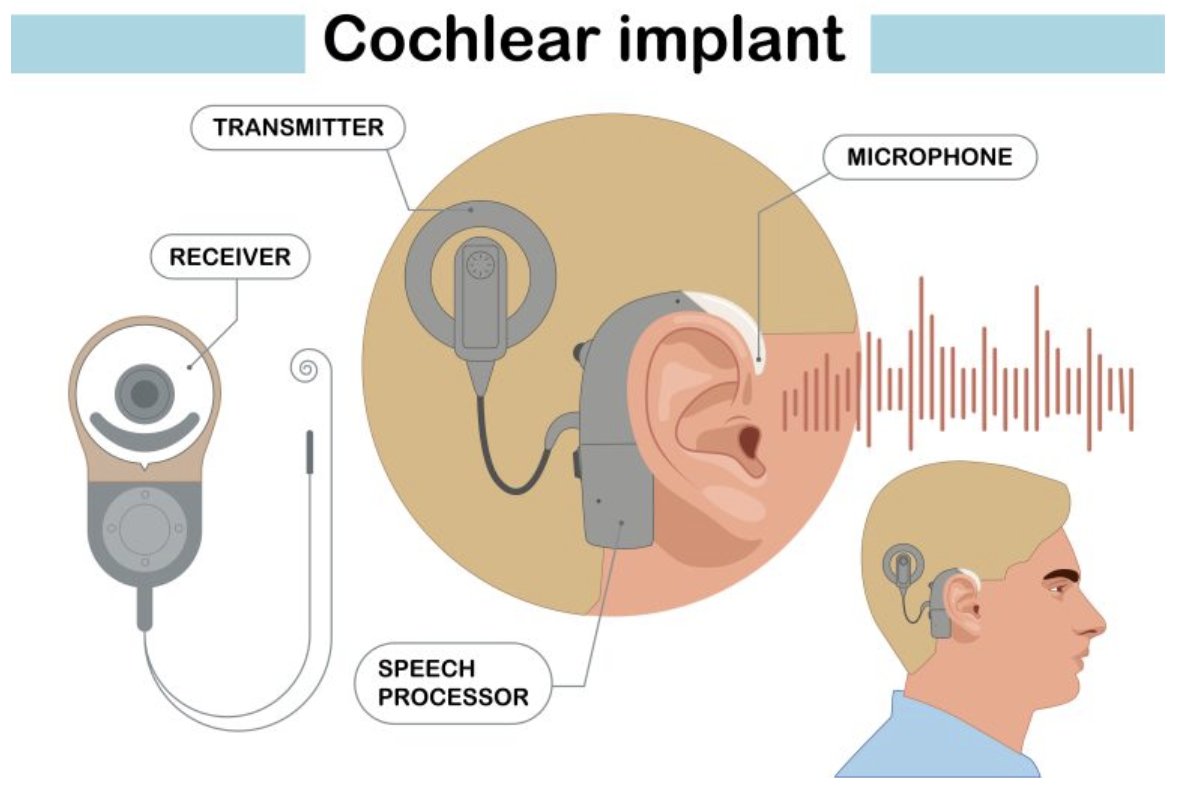From Silence to Sound: Dr. Stephen Cragle Brings Cochlear Implants to Central Minnesota
Have you ever been in a crowded room, struggling to hear the person next to you? Or maybe at a live concert, where the singer’s words become inaudible? It’s frustrating, isn’t it? Now, imagine feeling like this every moment of every day. For roughly 20% of the population, this is a daily reality.
For the 1.5 billion people worldwide with some degree of hearing loss, these experiences can be overwhelming. Hearing loss is the third most common chronic health condition in the United States, and by 2060, an estimated 30% of Americans will experience some level of hearing impairment. Fortunately, advancements in technology have dramatically improved the lives of many, and increased awareness about hearing loss has led to earlier interventions.
However, there are cases where even the best hearing aids fall short. Individuals with sensorineural hearing loss—a nerve-related hearing impairment—may find that no hearing aid can fully restore their hearing, no matter how advanced. When patients reach this point, it’s time to explore other options, bringing us to an exciting innovation now offered at St. Cloud Surgical Center: the cochlear implant. We recently spoke with Dr. Stephen Cragle from the St. Cloud Ear, Nose, and Throat Clinic about his journey with cochlear implants and how he has introduced this life-changing technology to our center.

Stephen P. Cragle, M.D. has worked at the St. Cloud Ear, Nose, and Throat Clinic since 1992
For over twenty years, Dr. Stephen Cragle has immersed himself in the world of cochlear implants. As a general otolaryngologist with expertise in all areas of the head and neck, Dr. Cragle became particularly fascinated by the intricate connection between our ears and brains. This passion, combined with his 30+ years of experience as an ENT physician, made him the ideal candidate to introduce cochlear implants to Central Minnesota. As of September 2024, he remains the only surgeon in the region performing these life-changing procedures.
While Dr. Cragle has seen significant success with his treatments, establishing his cochlear implant practice wasn’t without challenges. Despite recognizing the strong demand for such a program in Central Minnesota, insurance companies were initially reluctant to support it, and patients faced difficulties securing reimbursements. As a result, the idea was put on hold until 2014, when Dr. Cragle attended a course by Cochlear Corporation in Denver. The experience reignited his commitment, and he resolved to bring cochlear implants to his patients—no matter the obstacles.
After completing his training with the Cochlear Corporation, Dr. Cragle launched his first cochlear implant program at the St. Cloud Hospital in 2015. There, he perfected his surgical technique and helped many patients restore their hearing. As his expertise grew, Dr. Cragle saw an opportunity to bring cochlear implant procedures to an outpatient setting and approached St. Cloud Surgical Center. Finally, in 2024, the center welcomed its first cochlear implant patient. This move allowed Dr. Cragle to perform the surgeries more efficiently while offering patients a more cost-effective option for their treatment.
The W’s of Cochlear Implants: What, Who, and Why
What is a cochlear implant?
A cochlear implant is a surgically implanted device that vastly improves the volume and clarity of sound for patients with profound hearing loss.
The implant consists of four key components: a microphone, a speech processor, a transmitter and receiver (or stimulator), and an electrode array. Together, these components bring sound from the external environment to the auditory nerve.
First, the microphone picks up sound from the patient’s surroundings and sends it to the speech processor, which arranges the sound for processing. The transmitter and receiver (stimulator) then convert the processed signals into electrical impulses. Finally, impulses are sent to the group of electrodes, which deliver them to specific regions of the auditory nerve, bypassing the eardrum, ear bones, and cochlear fluids and directly stimulating the hearing nerve.
Though small in size, this sophisticated device has a profound ability to transform lives.

Who are cochlear implants for?
Cochlear implants are designed for patients with sensorineural hearing loss. Two main types of patients may benefit from cochlear implants:
- Patients born deaf or hard of hearing
- Patients who have developed hearing loss throughout their lives
At St. Cloud Surgical Center, we perform cochlear implants on patients ranging in age from 12 to 92. However, we do not currently perform the procedure on children under 12.
A patient may be a strong candidate for cochlear implants if their sensorineural hearing loss is so severe that even the most advanced hearing aids are no longer effective in maintaining conversations.
If you or someone you know has sensorineural hearing loss, Dr. Cragle and his team of audiologists at the St. Cloud Ear, Nose, and Throat Clinic can perform a series of tests to assess the extent of the hearing loss. These tests measure word comprehension, speech clarity, and word recognition.
Why would someone choose cochlear implants?
For individuals struggling with sensorineural hearing loss, everyday life can be a constant challenge. Many patients with this level of hearing difficulty who consult Dr. Cragle have a word recognition score as low as 20%. This means they only understand one out of every five words. With such limited comprehension, it becomes incredibly difficult to carry on a phone conversation, enjoy a meal at a restaurant, or even visit with loved ones in a group setting. However, with cochlear implants, we can improve that score to 75%, or three out of four words, allowing people to rejoin the conversation and regain a sense of normalcy.
For Dr. Cragle, witnessing the transformation in his patients after receiving their implants is nothing short of remarkable.
“When we put in a cochlear implant, and grandpa now hears the grandkids, it’s a new life for him. It’s absolutely amazing. And that’s why I do what I do.”
The Cochlear Implant Process
The first step is the surgery itself, which typically lasts about two hours. During the procedure, the surgeon will make an incision behind the ear and remove a small section of bone to create a tunnel into the inner ear. This tunnel allows the wire from the device to pass underneath the eardrum and into the cochlea. Once the wire is in place, the rest of the internal device is implanted beneath the skin, just under the skull bone, behind the ear.
After surgery, the incision is sutured, and a tight dressing is applied to reduce swelling. The dressing remains in place for the first two days, as controlling swelling is essential for a smooth recovery. Patients usually go home the same day to rest and recover comfortably.
Once the swelling subsides—usually around 3 weeks—the external device (hearing aid) can be placed. This involves attaching a small magnet to the back of the head, which connects to the internal device. The external electronics are housed in a unit that hooks behind the ear, similar to a traditional hearing aid.
At this point, the audiologist begins the programming process, which can take anywhere from a few weeks to a few months, depending on the patient.
While cochlear implants are highly effective, they offer a different way of hearing that takes time to adjust. Some patients report that familiar sounds, like dogs barking, may initially resemble a mouse squeaking or that running water may have a ringing tone. Over time, however, the brain adapts to this new method of hearing. For many, cochlear implants bring about life-changing improvements, allowing them to enjoy activities once again, like dining out, talking on the phone, and engaging with family and friends.
If you are experiencing profound hearing loss and have not seen success from previous treatments, it may be time to talk to your provider about a cochlear implant. The solution you have been looking for could be right around the corner. Contact us today for more information.
Sources:
What to Expect from Your Cochlear Implants – Dr. Stephen Cragle
https://www.nidcd.nih.gov/health/statistics/quick-statistics-hearing
https://www.nidcd.nih.gov/health/cochlear-implants
Previous Post: